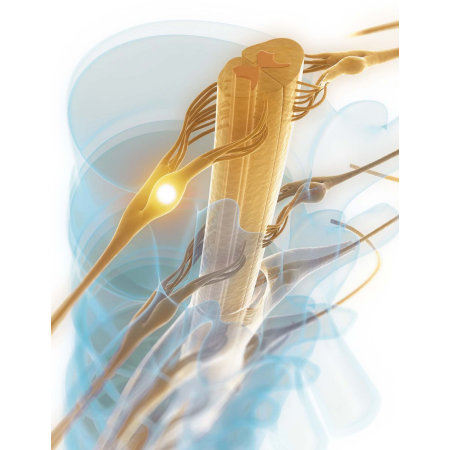What is Spinal Cord Stimulation (SCS)?
SCS may offer hope for many of the estimated 50 million people in the U.S. who suffer from chronic pain. SCS works by using mild electrical impulses to the spinal cord, masking the pain message traveling to the brain.
Depending on the type of stimulation therapy used, the painful sensation may be replaced with a soothing, tingling sensation or no sensation at all.
SCS may be prescribed for chronic intractable pain of the trunk and/or limbs, including unilateral or bilateral pain associated with failed back surgery syndrome or intractable low back pain and leg pain. Many people with failed back surgeries have had success with SCS. It is most commonly used to treat low back and lower extremity pain.
Indications for Use. The Spinal Cord Stimulator Systems are indicated as an aid in the management of chronic intractable pain of the trunk and/or limbs including unilateral or bilateral pain associated with the following: failed back surgery syndrome, Complex Regional Pain Syndrome (CRPS) Types I and II, intractable low back pain and leg pain. Associated conditions and etiologies may be: radicular pain syndrome, radiculopathies resulting in pain secondary to failed back syndrome or herniated disc, epidural fibrosis, degenerative disc disease (herniated disc pain refractory to conservative and surgical interventions), arachnoiditis, multiple back surgeries.
Contraindications, warnings, precautions, side effects. The SCS Systems are contraindicated for patients who: are unable to operate the SCS System, have failed trial stimulation by failing to receive effective pain relief, are poor surgical risks, or are pregnant. Refer to the Instructions for Use provided with the SCS System or Pain.com for potential adverse effects, warnings, and precautions prior to using this product.
What are the steps of an SCS procedure?
Trialing
One of the advantages of SCS therapy is that the patient gets to test drive an external version of the device to see if SCS is effective for their pain.
At the beginning of the trial period, the physician places insulated leads with a simple procedure similar to an epidural injection. The leads are connected to an external trial stimulator that is tucked inside an external belt. The patient also gets a wireless remote control so they can increase or decrease the electrical impulses to manage their pain. The external version is typically worn anywhere from a few days to one week. This trial period gives the patient the opportunity to decide if SCS manages their pain.
Permanent Implantation
After the trial device, the patient and physician decide whether or not SCS is a therapy option that best suits their needs. If they decide to go forward, then the patient will undergo another procedure during which the physician implants leads and a stimulator called an Implantable Pulse Generator (IPG). In some cases, a physician may recommend a surgical lead, also known as a paddle lead. In this case, the paddle lead is placed at the target site during the surgical procedure. Patients may remain awake during this procedure, under local anesthesia and light sedation. In other cases, general anesthesia may be administered.
Besides a cordless remote control, the patient will also receive a portable, cordless charger and a base station for the charger.

